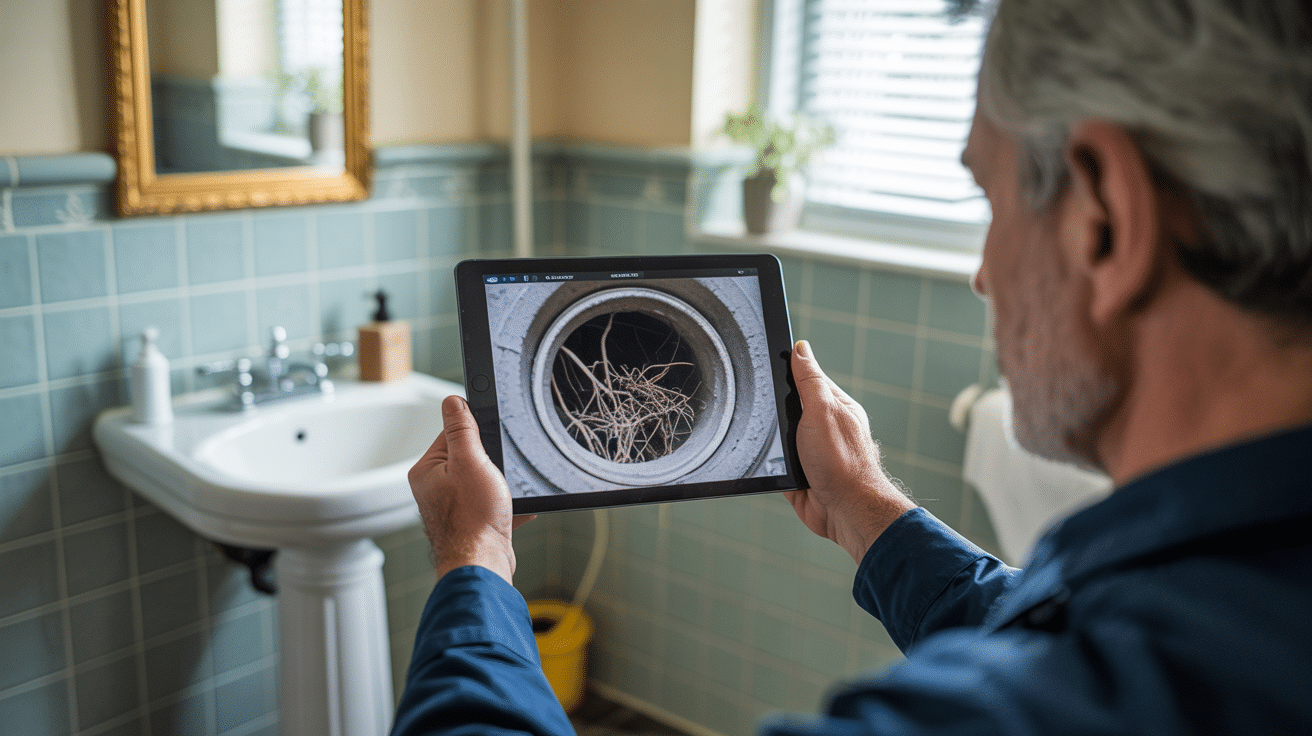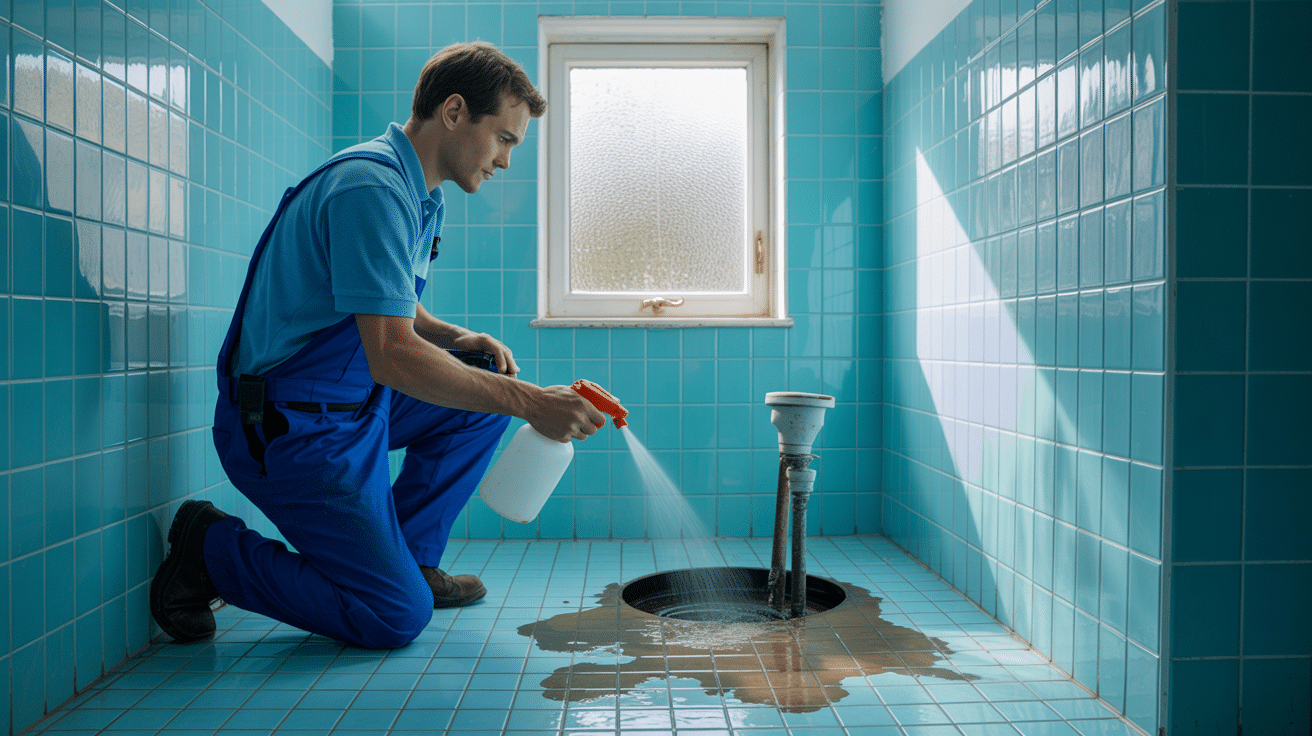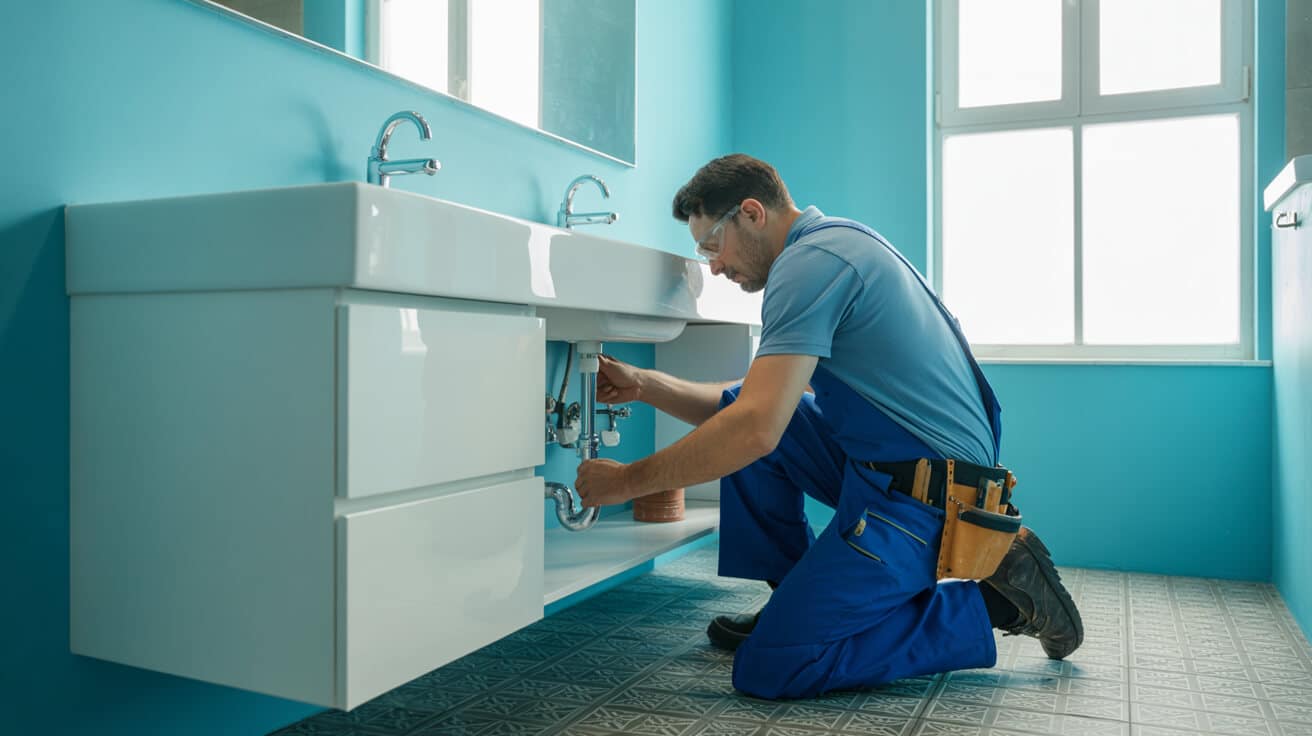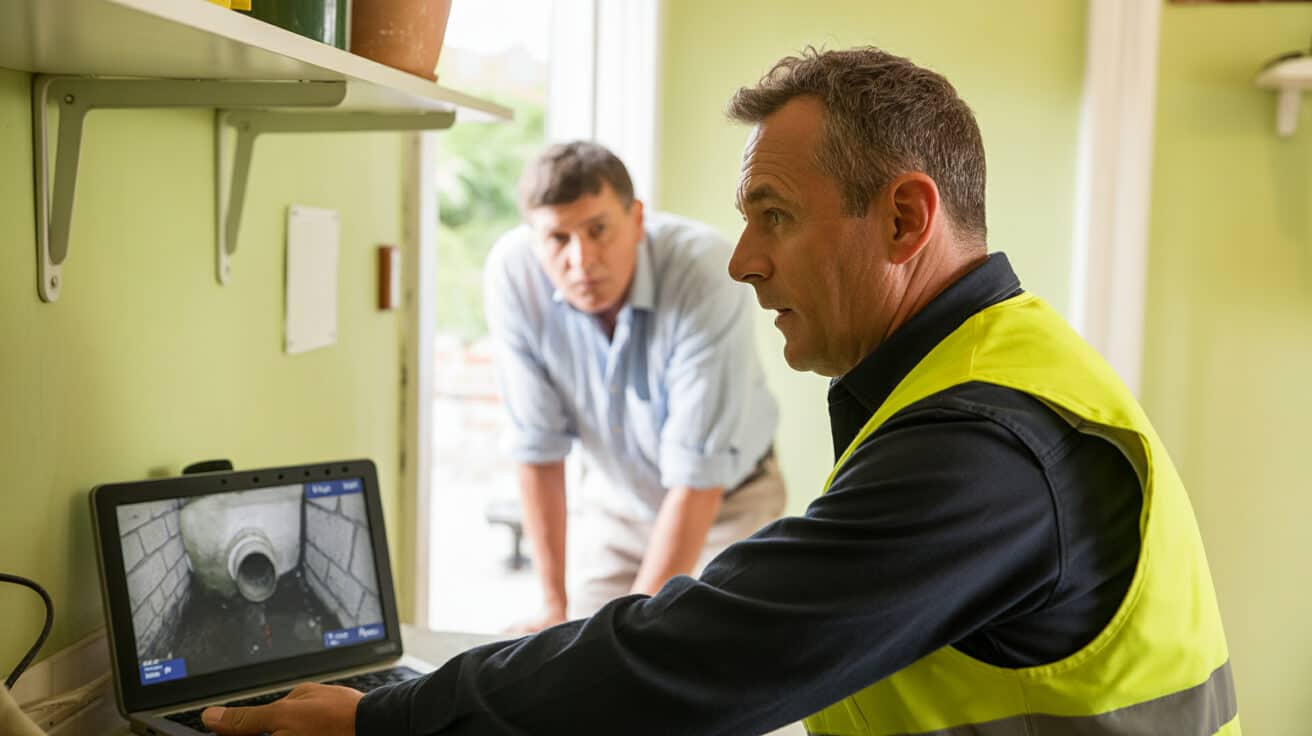 How to Maximise Space in a Small Bathroom 25 Clever Ideas
How to Maximise Space in a Small Bathroom 25 Clever Ideas

How Can You Maximise Space in a Small Bathroom Without Losing Style or Comfort?
Even the most compact UK bathroom is brimming with hidden capacity—if you tackle it with a system, not just a shopping spree. For homeowners, landlords, letting or managing agents, commercial property owners and local authorities, a small bathroom is often a daily battleground between functionality and frustration. But the trick isn’t clever furniture or Pinterest boards; it’s upgrading your approach: respecting hidden regulations, planning for real use, and making every inch work, not just look good.
Most small bathrooms disappoint not for lack of space, but for lack of strategy. Reimagine yours—every inch counts if you get the order right.
At Plumbers 4U, we’ve seen that the difference between cramped and comfortable is rarely square footage—it’s trade-level logic, law-aligned upgrades, and little rituals that snowball into daily convenience. This guide breaks down 25 proven, regulation-native strategies for maximising space, keeping compliance tight, and ensuring comfort isn’t sacrificed along the way. Whether you’re fixing up your home’s tired ensuite or managing a fleet of rental bathrooms, this is your blueprint—rooted in WRAS, G3 and Part G, but cut for real-world use.
Why Is a Compliance-First Mindset Essential When Upgrading a Small Bathroom?

Space is precious—so is your legal protection. Every meaningful gain in UK bathrooms begins not with “what looks cool” but “what the law allows and insurance trusts.” Ignore that, and your stylish upgrade can snowball into leaks, disputes or rework costs.
How Do Regulations Actually Shape What’s Possible?
- Fixture Spacing Matters: Part G in the UK Building Regulations sets out minimum clearances for toilets, basins and showers. Ignore these by squeezing in oversized units and you risk both poor cleaning access and failed inspections when you come to let, sell, or re-mortgage.
- Product Certification Counts: Only WRAS-approved taps, toilets and wastes are legally sound for new installations and almost every upgrade involving a landlord or tenant. Even small items like push-fit connectors are compliance-critical.
- Documentation = Defence: For landlords, agents and commercial managers, only logged, certified plumbing work is respected in legal disputes or insurance claims. No receipts or instal photos means no cover.
Real spatial gains start with legal confidence: compliance makes space usable, not just present.
Stepwise, compliance-first thinking leads to bathrooms that feel larger, need fewer repairs, and pass every audit—without last-minute changes or regulatory headaches. Upgrades that side-step this logic almost always get undone.
Where Do Most Small Bathrooms Actually Lose Usable Space?

The main villain isn’t “not enough room”—it’s habits and layout choices that quietly steal space over months or years. Seasoned installers see it quickly: clutter piles up, single-use furniture blocks movement, and shortcuts introduce avoidable risks. Every space lost is a compounder—each bottle on a ledge or boxy vanity is a daily energy drain.
What Daily Habits Turn Good Bathrooms into Chaos?
- Surface Magnetism: Bottles, make-up, and tools linger on every flat surface, especially when storage is weak. This hides leaks, encourages mould, and obstructs cleaning.
- The Single-Use Trap: Bulky storage units under sinks or deep floor-standing cabinets reduce floor visibility, block door swings, and make cleaning or leak checks a pain.
- Ignoring Perimeter Potential: Most users forget the wall space over cisterns, radiators, or even entry doors—prime real estate for slim storage that never interrupts elbow room.
- Regulation Risks: DIY “fixes” with unapproved brackets or non-WRAS parts might free space for a day but are a recurring headache once a compliance inspection or claim lands.
Layout planners attack wasted space by first auditing user routines, then eliminating redundant or underused items. It’s not about having less—it’s about setting up the room so that what matters most is always accessible, protected, and compliant.
The illusion of too little room rarely survives a methodical declutter and honest layout audit.
Which Space-Saving Upgrades Actually Deliver in the Real World?

Not all “hacks” found online stand up to daily use, tenant turnover, or UK trade standards. There’s a world of difference between clever and compliant—and longevity favours only one.
Can Decluttering Alone Transform Your Bathroom Functionality?
The return-on-effort is sky high. Every surface or drawer cleaned out not only gives back visual space—it makes it faster to spot leaks, track mould, and keep drains clear.
- Shelf Reset: Every bottle and brush blocked from view is a possible slow leak missed during checks. Strip surfaces, then only restore what is truly daily-use.
- Product Audit: Expired or duplicate items clog up traps and drains, especially in high-turnover flats. Cull with a simple rule: single purpose, single slot.
- Function Over Habit: Place the few things you use within reach, and let the rest leave the room or get put behind closed doors.
As every callout engineer knows, two-thirds of hidden leaks in UK rentals start with “I couldn’t see around the bottles for weeks.”
Why Does Building “Upward, Not Outward” Always Beat Bulky Furniture?
Floor space is gold—don’t sacrifice it for boxes or bulk. In small bathrooms, vertical planes are your best friends:
- Above-Door or Cistern Shelving: Perfect for spare towels or guest supplies you don’t need daily.
- Floating Caddies or Corner Poles: Specially valuable in showers or tight corners, and often approved even in listed or tenanted properties because they require minimal drilling.
- Tall, Narrow “Tower” Units: Hide cleaning products or toilet rolls from sight while keeping floors walkable.
All these solutions must meet two vital checks: at least 200mm clearance from radiators and no blockage of escape routes. It’s easy to boost storage by 30–50% with these strategies without breaking a single rule.
Are Wall-Mounted, Recessed, or Floating Units Worth It?
The difference between a boxy bathroom and one that feels double its size often comes down to what’s on the floor—and what’s on the wall.
- Wall-Mounted Basins, Loo Units and Vanity Drawers: These make cleaning and drainage checks much quicker and safer, eliminate trip points, and are fundamental for accessible or future-proofed spaces.
- Recessed Niches: Cut into stud walls, they store shampoo, cleaning products, or spare soaps at easy reach, but never block sightlines in a shower or basin area.
- Engineer-Grade Fixings: Always specify installer-approved brackets and WRAS or G3-certified sealants for proper safety and to avoid movement, leaks or failures.
Landlords and owners get fewer complaints and quicker cleaning; tenants appreciate easier maintenance and more “leg-room.” The up-front investment pays for itself once over.
What Visual and Psychological Upgrades Actually Double a Bathroom’s Perceived Size?

Real space is only part of the equation—how users and inspectors feel in a room is shaped by light, lines, and easy-to-clean finishes.
How Do Mirrors, Light, and Open Sightlines Change Everything?
- Large-Panel or Wall Spanning Mirrors: Reflect both daylight and fixtures, “stretching” the room visually and making it much simpler to judge cleanliness and catch leaks.
- Consistent, Soft Colour Palettes: Stick to off-whites, gentle greys, or perhaps soft blue tints. These help both artificial and natural light bounce, which aids both daily routines and periodic compliance checks.
- Swap Heavy Curtains for Clear or Soft Frosted Shower Screens: This trick removes the blur of movement in and out of the room, opening up sightlines to the floor and fixtures.
Pro tip: Don’t place mirrors directly opposite a toilet—use walls near the basin or door for both function and comfort.
Why Do Dual-Purpose Fixtures Win for Storage and Longevity?
Invest in features that do double duty:
- Under-Basin Vanities With Built-In Drawers: Hide away clutter, spare towels, bins, or emergency cleaning products with zero floor impact.
- Heated Towel Rails With Shelving: Heat towels but also act as a “vertical wardrobe,” freeing up classic bar rails for easy air movement.
- Magnetic Strips or Accessory Bars: Fit inside cupboard doors or on tiled splashbacks—ideal for quick access to clippers, razors or cleaning tools, and safe for kids if placed at appropriate height.
Well-designed visual systems invite routines that stick. They also lower break-fix rates by discouraging “workarounds” or unsafe DIY storage hacks.
A bathroom neglected until handover is a liability; one visually inviting order is an asset.
How Do You Make Order Last—Even With Tenants or Busy Families?

True space doesn’t survive on clever upgrades alone. It’s ritual—the quiet, everyday routines—that keep bathrooms from regressing into chaos, especially in multi-user spaces.
What Habits Keep Bathrooms Spacious and Compliant?
- Daily Two-Minute Surface “Reset”: A quick wipe of every visible surface spots leaks, leaves fewer places for clutter to congregate, and reduces weekly cleaning time.
- Quarterly Photo Comparison: Baseline your bathroom every few months. For landlords and agents, this creates a document trail that’s invaluable for deposit disputes or insurance claims.
- Smart App Reminders: Small regular jobs—like checking the extraction fan or resealing a tray—get forgotten unless prompted. “Set it and forget it” tech habits mean fewer system failures and repair costs.
- Checklist Maintenance: Agents piloting checklist routines report almost 50% fewer tenant-reported issues over a year *(Source: homesandgardens.com)*.
Scripted, shared routines protect against expensive surprises—across homeowners, HMO managers, and rental agents.
When Is It Best to Bring in a Bathroom Pro?
A compliance audit isn’t a luxury—it’s a reputational safeguard:
- On-Site or Remote Walkthroughs: certified engineers confirm instal gaps, WRAS compliance, and user modifications or additions (think DIY bidets, water fountains or added shelves) likely to break code or cause warranty voids.
- Photo-Driven Consultation: Modern installers can now provide desk-based audits, using close-up photos and layout plans to flag any regulation risks—no site visit required.
- Documentation for Audit and Insurance: Detailed records (with dates, fitments and part numbers) often mean faster claims and lower premiums, plus less friction on resale or tenant handover.
Professional review may feel like an investment, but it’s insurance against ten times the cost in future disputes or compliance failures.
How Can You Guarantee Upgrades That Stay Durable and Compliant as Rules Change?

Lasting space improvements aren’t made with short-term thinking. They’re built on systems, documentation, and a bias for professional-grade solutions designed for real-world turnover.
Why Is Certification More Than Just a Box-Ticking Exercise?
- WRAS and G3-Only Solutions Count for New Lets or Insurance: Anything outside these standards may face removal notices or invalidate policies.
- Case-Backed Proof: Properties with professionally documented upgrades claim faster, let quicker, and retain reputation. The evidence? UK trade data shows bathrooms with certified, photo-logged upgrades outscore comparables by 30% in tenant and buyer satisfaction.
- Only Pro-Installer Sign-Off Shields Against Repair Disputes: Too many “hacks” or kit instals are rejected by both agents and insurers—certified labour is as important as certified kit.
What Are the Tangible Gains When You Upgrade the Right Way?
- Landlords & Agents: No surprise compliance failures, higher rentability, fewer call-backs, and audit-proof records.
- Homeowners: Fewer repairs, faster cleaning, better remortgaging outcomes, and a space you’re happy to show off.
- Commercial & Council Managers: Harder-wearing features, minimised disruption, and tick-box handover proof.
Long-lasting bathrooms are never DIY shortcuts—they are compounding investments in daily ease and reputational security.
Ready-to-Run: The Expert’s Checklist for a Space-Smart Compact Bathroom

Sucess starts long before you search the web for storage baskets or “clever” mirrors. The pros use a repeatable workflow that bends both law and logic in your favour. Here’s your trade-proven process, stepwise:
- Declutter First: Get every non-daily-use item out—this is non-negotiable.
- Map Storage Vertically: Prioritise wall space, above-door shelves, and niches over bulky floor units.
- Upgrade to Wall-Mounted and Recessed Storage: Turn voids into value, freeing floors and simplifying cleaning.
- Defend Every Change With Regulations: WRAS, G3 and Building Regulations Part G are your friends; compliance, not convenience, is your insurance.
- Institutionalise Habit: Smart checklists and timely photos make order automatic rather than aspirational.
- Bring in Help When Needed: A pro engineer or compliance walkthrough is a small upfront investment that prevents expensive fixes later.
Follow this and you’re consistently building rooms that feel bigger, function cleaner, and stand up to audit—again and again.
Who Benefits Most From Each Upgrade—A Stakeholder Matrix for Small-Bathroom Projects
One solution rarely fits all, so choosing the right upgrade for the right property journey sharpens outcomes and fends off future disputes or complaints. See where each fix lands best:
| Solution | Stakeholder(s) | Key Regulation |
|---|---|---|
| Floating Vanity & Basin | Owners, Landlords | WRAS fixings, wall integrity |
| Over-Door Shelf/Cabinet | Agents, Tenants | Avoid deep fixings in lets |
| Magnetic Storage Rail | Families, HMOs | Mount above child safety line |
| WRAS-Approved Tap Kits | All | Mandatory for compliance |
| Quarterly Photo Log | Landlords, Agents | Essential for handover/dispute proof |
| Recessed Shower Niches | Refurb Projects, Homeowners | WRAS, building reg damp-proof |
| Heated Towel Rail/Shelf | Families, Agents | Clearance for radiator, safe wiring |
| Pro Compliance Audit | All—esp. landlords, block mgr | Certified record for insurance |
A stepwise pick from this matrix means fewer surprises, fewer disputes, and more universal wins for every link in the property chain.
What’s the Route to a Spacious Bathroom That Stays Trouble-Free Year After Year?
Sustainable order and comfort don’t depend on gadgets or the latest colourway—they’re a blend of structure, documentation, and daily ritual.
- Clear First, Plan Second: Remove, measure, map, before you buy or fit.
- Go Up the Walls: The best “extra space” sits over the door, beside the mirror, or inside a false wall.
- Regulation Over “Cleverness”: Non-compliant ideas cost extra in the end—patience is your friend.
- Lock In Rituals: Make annual audits and daily resets as natural as locking the door.
- Invest in a Pro Review: Even one remote consult saves time, money and future complaints.
The bathroom that just works—year in, year out—is one that asks less of you because the structure takes care of the rest.
Move Past Small—Demand More From Every Inch: Plumbers 4U Have You Covered
Your space can either challenge you every day or make life flow easier. Plumbers 4U specialises in turning cramped, rule-burdened bathrooms into spaces that serve you, your tenants, and your reputation for years. Our WRAS and G3-certified engineers offer trade-proofed advice, visual layout reviews, and habit-based upgrades that don’t just look clean—they stay clean. For a bathroom that scales beyond its size (and never fails an inspection), get in touch with Plumbers 4U today. Every square inch is ready to serve—if you claim it with purpose.
Frequently Asked Questions
What overlooked factors drive the greatest value in small bathroom upgrades for multiple property stakeholders?
Unlocking serious value from a small bathroom is about more than squeezing in an extra cabinet. It’s how you set up ongoing returns for everyone involved—homeowners, landlords, letting agents, property managers, and local authorities. When the right upgrades are chosen, you don’t just tidy up the present; you pave the way for smoother tenancies, safer compliance checks, and a property that stands out in crowded markets.
Strategic choices, such as smart plumbing layouts or WRAS-certified tapware, limit maintenance headaches and draw a clear line under deposit schemes and compliance audits. Homeowners get everyday comfort and higher resale confidence. Landlords and agents avoid disputes by keeping access routes and shutoffs visible. Commercial settings—think HMOs or managed flats—see fewer emergencies and tighter documentation for audit trails. Every group benefits when improvements are mapped against real property journeys, not just today’s style trends.
Where do property journeys see outsize gains from thoughtful upgrades?
- Lettings and HMO management: Fast tenant turnovers, clear compliance evidence, fewer complaints and late-night calls.
- Home resale or remortgage: Upgrades that bring visual “wow” but also tick legal and practical boxes attract better buyers.
- Facility management: Documented, accessible installations mean less downtime and quicker response when a repair is needed.
- Local authority or licencing: Layout and fitting choices that respect UK spacing and drainage rules speed up approval and keep fines off the table.
Well-planned improvements echo in every yearly inspection and tenancy renewal—your choices build lasting reputation.
Plumbers 4U’s role is to ensure that each fit-out hits every legal, safety, and comfort note so your bathroom doesn’t just look bigger but delivers more, year after year.
Which design shortcuts and product missteps most often undermine UK bathroom upgrades?
Jumping for a quick-fix or generic online kit might feel like a shortcut, but these missteps tend to snowball over time. Fitting unapproved tapware or boxing away valves behind cheap panelling doesn’t only risk leaks—it can invalidate insurance, violate WRAS or Building Regs, and generate disputes with tenants or buyers. Poorly installed floor units and non-compliant adhesives create access nightmares and rack up professional call-out costs.
What typical errors come back to bite stakeholders?
- Non-WRAS taps and shower fittings: May go unnoticed at first but can void the insurance at the moment you need it most.
- Overuse of permanent or bulky units: Hampers quick cleaning and turns minor drainage issues into major repair jobs.
- Permanently boxed-off pipework: Eliminates the ability to isolate water in emergencies, and fails inspection checks.
- Improvised storage with cheap adhesives: Peels in the UK’s humidity, damaging surfaces and leading to unsightly repairs.
| Pitfall | Issue Created | Safer Fix |
|---|---|---|
| Unapproved fittings | Insurance/claims collapse | WRAS-certified tapware only |
| Blocked plumbing access | Costly repair escalation | Removable panels or easy access |
| Excessive floor units | Hard to clean & maintain | Wall-hung, slimline options |
| Surface damage from adhesives | Deposit loss, unsightly | Freestanding, non-permanent kit |
Every time a hidden valve or cheap shelf fails, it’s not just a repair—it’s a paper trail you have to defend.
Every design call vetted by Plumbers 4U weighs not only today’s visual result but future repairs, disputes, and the legal line. These steps ensure property owners, agents, and tenants avoid show-stopping mistakes.
How do appearance and function intersect to make a small UK bathroom feel truly spacious?
The size of a bathroom isn’t just about square footage. The right details—edge-to-edge mirrors, floating vanities, and minimalist uncluttered sightlines—make any room live larger. Evidence from property sales and rental performance shows that visually “open” bathrooms sell and let quicker, and are rated higher by tenants for comfort and “feel.”
Glass shower screens (versus curtains), slim wall-mounted shelves, and the use of pale, moisture-resistant paints instantly lift the atmosphere. Under-sink baskets and vertical racks keep cleaning easy while reducing mess. Choosing fixtures and storage that leave the floor largely untouched doesn’t just trick the eye—maintenance teams and agents will thank you for it when they do inspections or quick repairs.
What are the most effective illusions and upgrades?
- Max-length mirrors: Double the perceived width, casting more light.
- Clear or frameless screens: Remove visual barriers, extend usable space.
- Low-profile, floating fixtures: Visibly expand the “floor,” aiding both cleaning and access.
- Brighter, WRAS-compliant paint and sealants: Easier to maintain and audit for HMO or council reviews.
- In-wall or pocket storage: Frees up both surfaces and routine pathways, leaving no clutter.
| Visual Hack | Core Benefit |
|---|---|
| Oversized mirror | Expanded light, reflects whole room |
| Floating vanity | Unbroken cleaning path, floor open |
| Frameless glass | Shower area feels part of the room |
| Built-in shelves | No lost surfaces, easier cleaning |
First impressions become lasting value—design earns you more than just an admiring glance; it locks in comfort and saleability.
Plumbers 4U maps these choices against property type and client need, ensuring every instal is both space-maximising and future-safe.
Which storage strategies maximise compliance, flexibility, and deposit peace in UK rental refits?
The safest bathroom storage in rented and shared properties is always the least permanent: easy to use, instal, and remove—zero drilling, zero risk, all benefit. Suction baskets, over-door racks, and freestanding corner towers leave surfaces and tiles unmarked, sidestepping most disputes and council complaints. Modern above-cistern towers requiring no screws add usable shelves where space is at a premium and pipes are often boxed in. Everything must leave access to critical shutoffs and isolation valves clear for emergencies or annual reviews.
Where does smart storage win over costlier built-in options?
- Deposit safety: Easily reversible, avoids conflict over “wear & tear.”
- Routine cleaning: No blockages, nothing for moisture to pool around.
- Inspections and emergencies: Full access to shutoffs—no rip-out if a leak occurs.
- Data-driven evidence: Before-and-after photos or QR logs double as proof for inventory disputes.
| Storage Approach | Tenant Risk | Agent/Landlord Risk | Compliance Win |
|---|---|---|---|
| Suction-cup caddies | No | Minimal | Yes |
| Corner towers | No | None | Yes |
| Over-door racks | No | None | Yes |
| Quick-release pad units | No | None | Yes |
In nearly every complaint review from UK letting agents, lack of compliant, portable storage—not big works—was the single factor separating disputes from fast returns.
Plumbers 4U’s upgrades fit this ethos—always considering tenancy turnover, council spot-checks, and peace of mind for every property role.
Why do UK legal and insurance standards make compliance-first upgrades non-negotiable—even in tiny bathrooms?
UK standards—WRAS for fittings, Building Regulations Part G and H for water and drainage, G3 for hot water safety—aren’t mere paperwork. Their enforcement is especially strict in compact bathrooms, where every millimetre counts and shortcuts get exposed. Ignoring WRAS approval, access rules, or proper documentation can void insurance, stall a property sale, land landlords or agents in deposit disputes, and even trigger council prohibition on new lets.
Council panels, insurers, and even tenants now expect digital or photographic evidence—of both proper installation and appliance marking. Updates without paperwork or skipped WRAS certifications risk entire portfolios, not just one property.
What are the new triggers for costly failure?
- Improperly labelled or marked installations: Fail inventory checks and can block agent sign-off.
- Hidden or inaccessible valves: Contravene Part G and council best practice guidance.
- Using non-certified installers: Leads to missing G3 or WRAS paperwork and compliance panic when things go wrong.
- Photo evidence shortage: Increasingly required for tenancies, grants, or renovation audits.
| Regulation Focus | When Required | Underlying Benefit |
|---|---|---|
| WRAS fittings | Upgrades & refits | Maintains claim validity |
| Full access to shutoffs | Always | Faster repairs, safety |
| G3 certificate (cylinder) | New HW systems | Grants, resale, audits |
| Audit-ready photo logs | Lettings, sales | Shields owner and agent |
Skimp now, pay later; the UK’s tightening property and letting standards make every shortcut twice as risky—and documentation more valuable than ever.
All of Plumbers 4U’s upgrades arrive audit-ready—compliance assured, paperwork in hand, insurance and market value protected.
What habits and aftercare routines protect your investment and ensure ongoing usability in tight bathrooms?
A lasting bathroom upgrade is made not just with better hardware, but with smarter habits and routine check-ins after the installer packs up. A two-minute daily tidy, quarterly “status” photos, and scheduled safety checks catch small messes and minor leaks before they turn into insurance claims or deposit headaches. For letting agents, facility managers, and landlords, recurring digital checklists or remote reviews add an extra shield against costly problems and let owners demonstrate compliance at a moment’s notice.
Which behaviours and checks outlive any instal?
- Daily reset: Surfaces wiped, all gear in accessible racks or towers, not on counters or cistern tops.
- Photo evidence: Use quarterly shots to defend against disputes, track wear, and document “as installed” hardware.
- Calendar reminders for checks: Extractor fans, window seals, and valve access—ping owners, agents, or tenants.
- Annual Plumbers 4U review: An outside eye catches drift from compliance and spots early plumbing or wear risks.
| Routine | Ongoing Win | Who Benefits |
|---|---|---|
| 2-min daily tidy | Prevents mess buildup | Tenants, busy owners |
| Quarterly photo | Dispute protection | Letting agents, managers |
| Safety reminders | Maintains long-term value | All property roles |
| Annual audit | Compliance, legal shield | Landlords, businesses |
Great bathrooms are built by habit as much as by the hammer—routine is your best defence in the UK’s most inspected room.
Plumbers 4U backs every handover with guidance on building these systems, offering digital checklists or follow-up checks so your remodel stays “future-fit” and manageable, no matter who’s in the property next.
How do the right upgrades today guarantee lower costs, fewer disputes, and smoother transactions for all?
Choosing a compliance-driven, user-first design for your small bathroom returns value at every stage: from maintenance savings and seamless sales, to fewer callouts and cleaner deposit returns. Layout improvements that keep pipes, valves, and shutoffs accessible mean fewer emergencies and faster trades access. Pre-certified fixtures ensure no insurance claim falls at the paperwork hurdle. Tenants stay longer, agents field far fewer disputes, and owners see their investment protect itself with minimal extra effort.
Documented, compliant upgrades set your property apart—whether you’re letting, remortgaging, selling, or just seeking a stress-free life. The data is clear: modern, regulation-aligned UK bathrooms draw better offers from buyers and renters, and create positive “chain reactions” for years in reduced time sunk on repairs, complaints, or red tape headaches.
Cost savings and time wins that add up year after year
- Fewer plumber callouts: Routine issues rarely escalate into emergencies.
- Shorter property voids and higher rental yields: Documented compliance speeds up re-letting and increases appeal.
- Dispute minimisation: Inventory defence and photo logs keep everyone on side.
- Audit confidence: Insurer, council, and grant audits pass cleanly, protecting revenue.
- Market edge: Smart upgrades catch the eye and pass the legal test, raising long-term value.
Owners who invest in compliance and future-friendliness aren’t just avoiding trouble—they’re building smoother transactions and less stressful tenancies for years ahead.
When you’re ready to make every inch of your small bathroom count—for today’s comfort and tomorrow’s documentation—Plumbers 4U has the team to deliver upgrades that work, evidence that stands up, and aftercare designed to keep you ahead.


